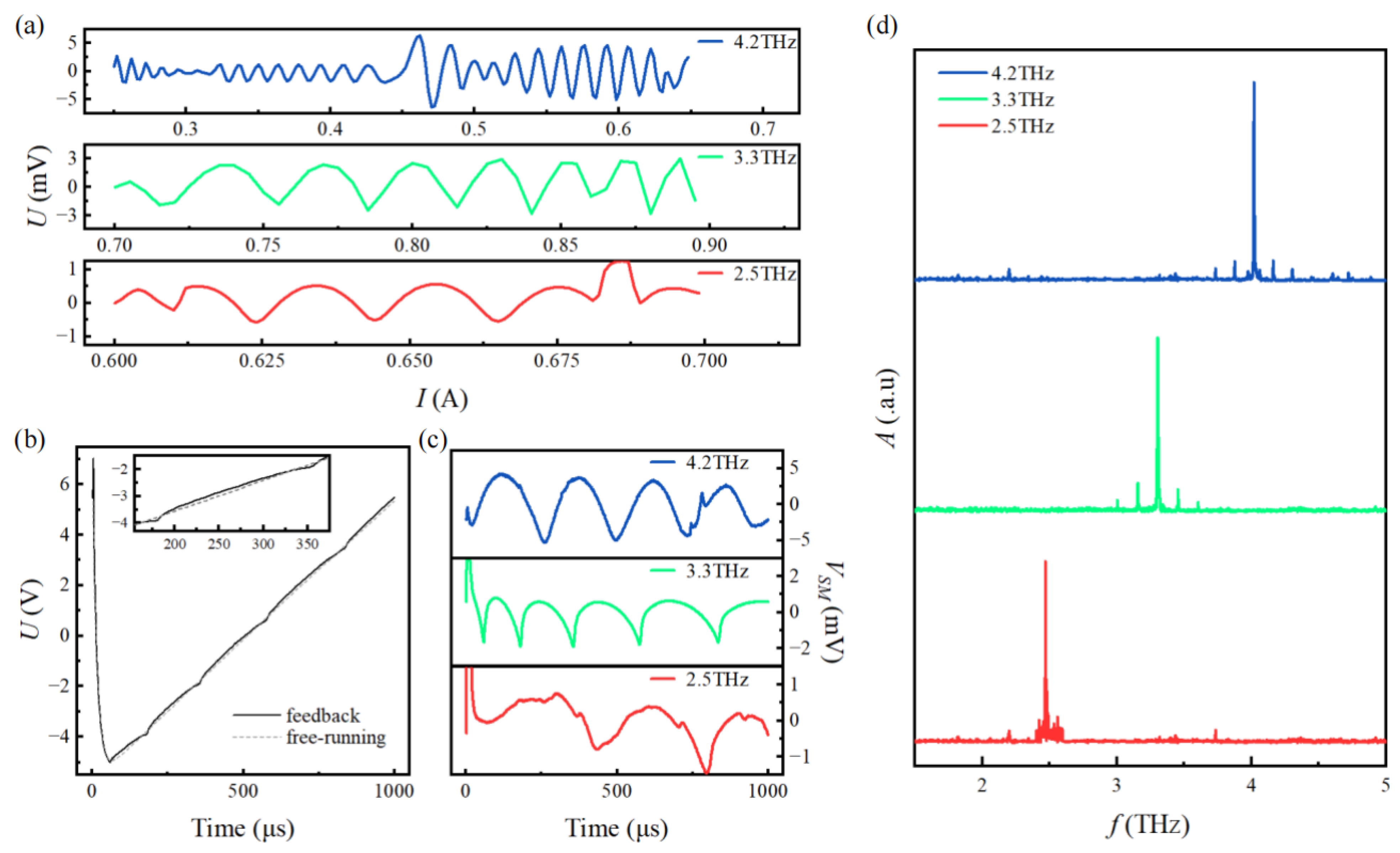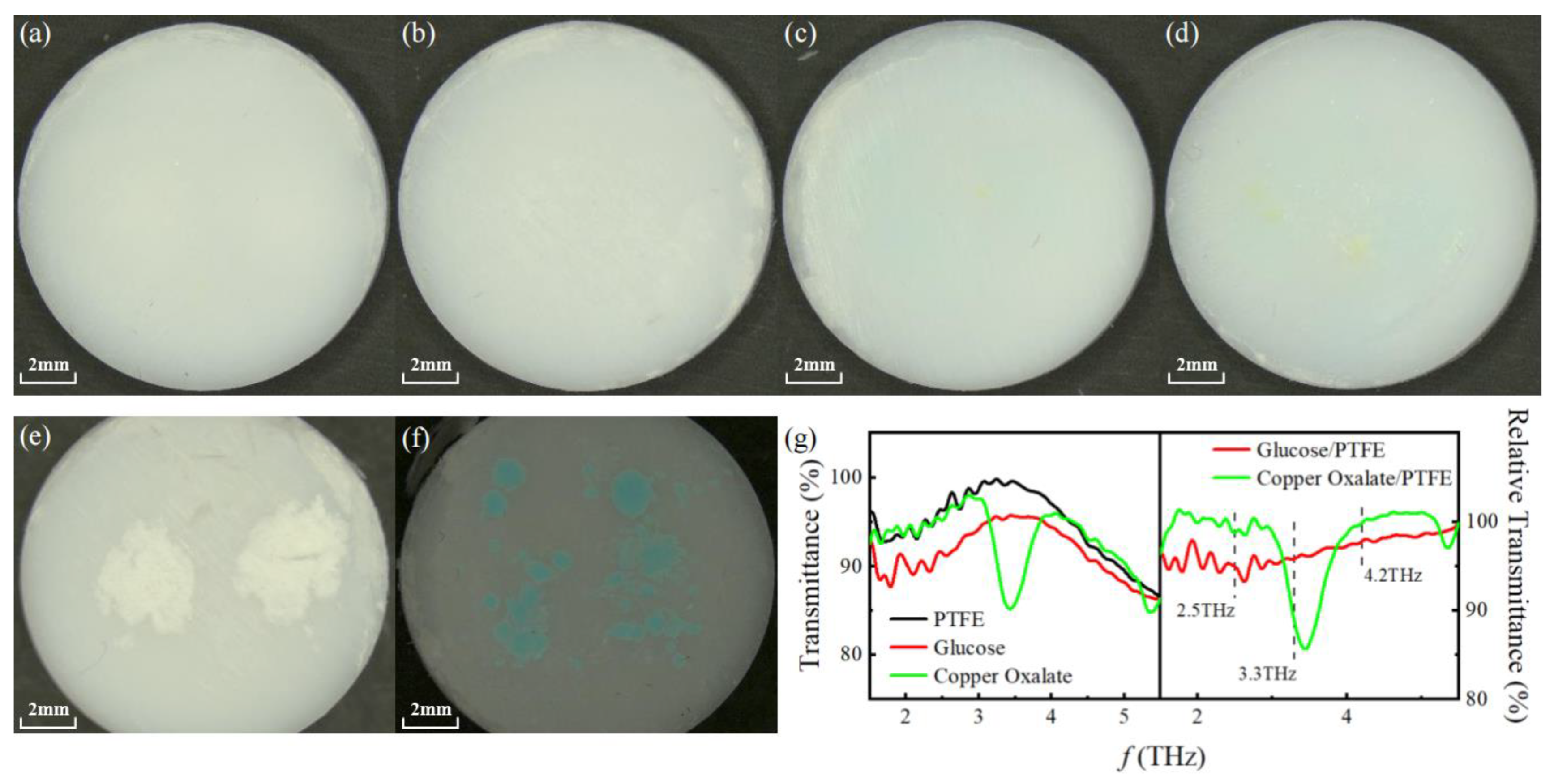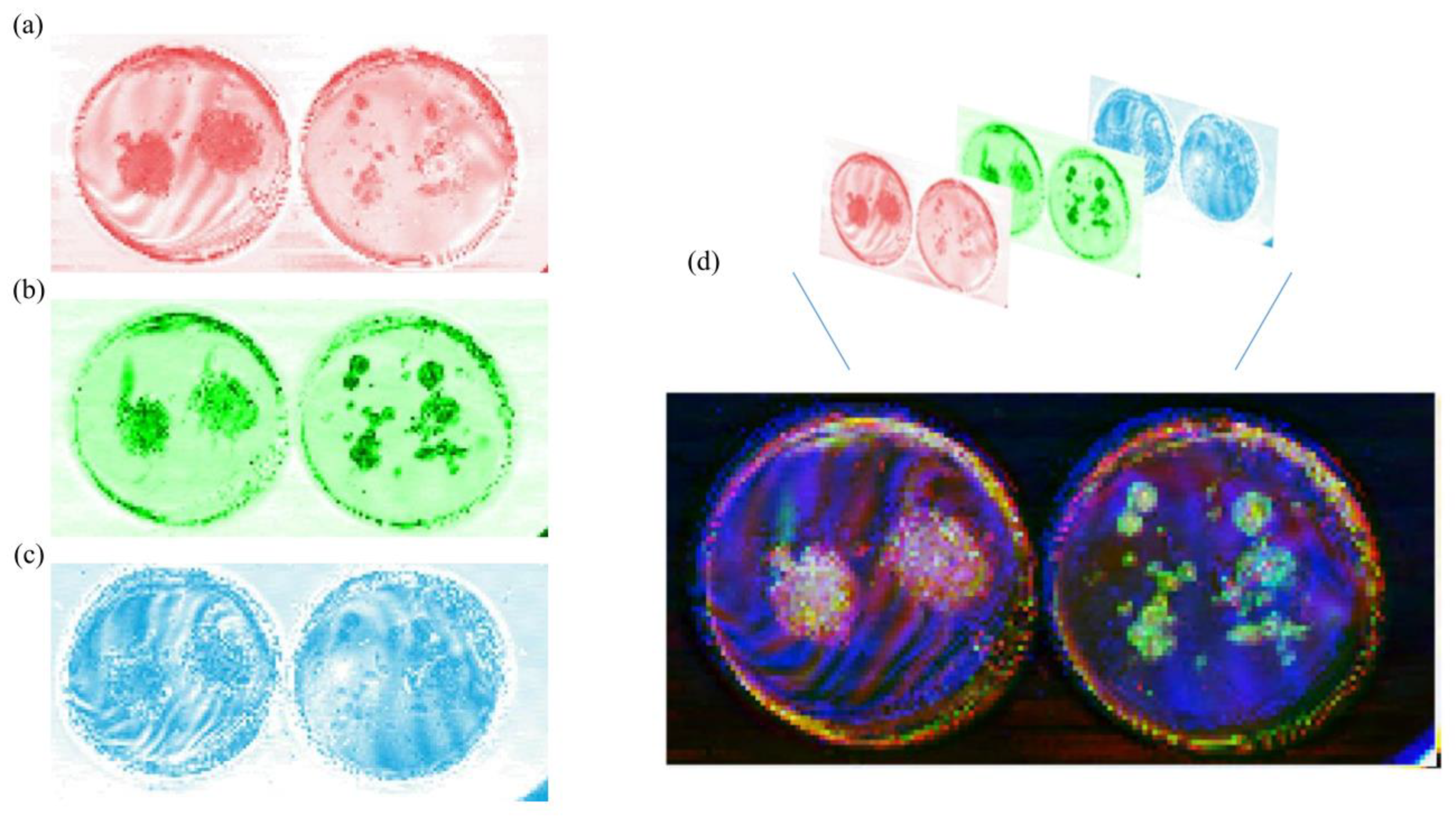Terahertz Multicolor Imaging of Opaque Objects Using Self-Mixing Interferometry with Quantum-Cascade Lasers
Abstract
1. Introduction
2. Physical Model and Experimental Setup
2.1. Self-Mixing Interference Theory
2.2. Acquirement of SM Interference Signal
2.3. Sample Preparation
3. Results
4. Discussion
5. Conclusions
Author Contributions
Funding
Institutional Review Board Statement
Informed Consent Statement
Data Availability Statement
Conflicts of Interest
Abbreviations
| SM | Self-mixing |
| THz | Terahertz |
| QCL | Quantum-cascade laser |
| DAQ | Data acquisition |
| PC | Personal computer |
| OAP | Off-axis parabolic reflector |
| PTFE | Polytetrafluoroethylene |
References
- Wen, P.; Amin, M.; Herzog, W.D.; Kunz, R.R. Key challenges and prospects for optical standoff trace detection of explosives. Trends Anal. Chem. 2018, 100, 136–144. [Google Scholar] [CrossRef]
- Li, J.S.; Yu, B.; Fischer, H.; Chen, W.; Yalin, A.P. Contributed Review: Quantum cascade laser based photoacoustic detection of explosives. Rev. Sci. Instrum. 2015, 86, 031501. [Google Scholar] [CrossRef] [PubMed]
- Fuchs, F.; Hugger, S.; Jarvis, J.; Yang, Q.K.; Ostendorf, R.; Schilling, C.; Bronner, W.; Driad, R.; Aidam, R.; Wagner, J. Imaging standoff trace detection of explosives using IR-laser based backscattering. Proc. SPIE 2016, 9836, 98362I. [Google Scholar]
- Ostendorf, R.; Butschek, L.; Hugger, S.; Fuchs, F.; Yang, Q.; Jarvis, J.; Schilling, C.; Rattunde, M.; Merten, A.; Grahmann, J.; et al. Recent Advances and Applications of External Cavity-QCLs towards Hyperspectral Imaging for Standoff Detection and Real-Time Spectroscopic Sensing of Chemicals. Photonics 2016, 3, 28. [Google Scholar] [CrossRef]
- Hugger, S.; Fuchsa, F.; Jarvisa, J.; Yanga, Q.K.; Rattundea, M.; Ostendorfa, R.; Schillinga, C.; Draida, R.; Bronnera, W.; Aidama, R.; et al. Quantum Cascade Laser based active hyperspectral imaging for standoff detection of chemicals on surfaces. Proc. SPIE 2018, 9755, 97550A. [Google Scholar]
- Kageyama, H.; Hayashi, K.; Maeda, K.; Attfield, J.P.; Hiroi, Z.; Rondinelli, J.M.; Poeppelmeier, K.R. Expanding frontiers in materials chemistry and physics with multiple anions. Nat. Commun. 2018, 9, 772. [Google Scholar]
- Weiskopf, N.; Edwards, L.J.; Helms, G.; Mohammadi, S.; Kirilina, E. Quantitative magnetic resonance imaging of brain anatomy and in vivo histology. Nat. Rev. Phys. 2021, 3, 570–588. [Google Scholar] [CrossRef]
- Sun, D.-W.; Pu, H.; Yu, J. Applications of hyperspectral imaging technology in the food industry. Nat. Rev. Electr. Eng. 2024, 1, 251–263. [Google Scholar] [CrossRef]
- Redo-Sanchez, A.; Heshmat, B.; Aghasi, A.; Naqvi, S.; Zhang, M.; Romberg, J.; Raskar, R. Terahertz time-gated spectral imaging for content extraction through layered structures. Nat. Commun. 2015, 7, 12665. [Google Scholar] [CrossRef]
- Stantchev, R.I.; Sun, B.; Hornett, S.M.; Hobson, P.A.; Gibson, G.M.; Padgett, M.J.; Hendry, E. Noninvasive, near-field terahertz imaging of hidden objects using a single-pixel detector. Sci. Adv. 2016, 2, e1600190. [Google Scholar] [CrossRef] [PubMed]
- Lukose, J.; Chidangil, S.; George, S.D. Optical technologies for the detection of viruses like COVID-19: Progress and prospects. Biosens. Bioelectron. 2021, 178, 113004. [Google Scholar] [CrossRef]
- Yin, X.-X.; Baghai-Wadji, A.; Zhang, Y. A Biomedical Perspective in Terahertz Nano-Communications—A Review. IEEE Sens. J. 2022, 22, 9215–9227. [Google Scholar] [CrossRef]
- Lukasz, A.S.; Jonas, W.; Yang, Y.; David, B.; John, R.; Qing, H.; Gerard, W. Terahertz hyperspectral imaging with dual chip-scale combs. Optica 2019, 6, 766–771. [Google Scholar]
- Seo, M.; Park, H.R. Terahertz Biochemical Molecule-Specific Sensors. Adv. Opt. Mater. 2020, 8, 1900662. [Google Scholar] [CrossRef]
- Yan, D.; Cui, J.; Li, X.; Zhang, L.; Li, J.; Lu, W. Enhancement of wide-band trace terahertz absorption spectroscopy based on microstructures: A review. Phys. Chem. Chem. Phys. 2023, 25, 31542–31553. [Google Scholar] [CrossRef] [PubMed]
- Sultana, J.; Islam, M.S.; Ahmed, K.; Dinovitser, A.; Ng, B.W.-H.; Abbott, D. Terahertz detection of alcohol using a photonic crystal fiber sensor. Appl. Opt. 2018, 57, 2426–2433. [Google Scholar] [CrossRef]
- Liang, L.; Hu, X.; Wen, L.; Zhu, Y.; Yang, X.; Zhou, J.; Zhang, Y.; Carranza, I.E.; Grant, J.; Jiang, C.; et al. Unity Integration of Grating Slot Waveguide and Microfluid for Terahertz Sensing. Laser Photonics Rev. 2018, 12, 1800078. [Google Scholar] [CrossRef]
- Zhou, Z.; Zhou, T.; Zhang, S.; Shi, Z.; Chen, Y.; Wan, W.; Li, X.; Chen, X.; Corder, S.N.G.; Fu, Z.; et al. Multicolor T-Ray Imaging Using Multispectral Metamaterials. Adv. Sci. 2018, 5, 1700982. [Google Scholar] [CrossRef] [PubMed]
- Chen, M.; Wang, Y.; Zhao, Z. Monolithic Metamaterial-Integrated Graphene Terahertz Photodetector with Wavelength and Polarization Selectivity. ACS Nano 2022, 16, 17263–17273. [Google Scholar] [CrossRef]
- Huang, W.; Li, C.; Fang, B.; Xu, J.; Liu, F.; Xu, L.; Tang, Y.; Hong, Z.; Jing, X. Research progress of terahertz wave dynamic control of digital coded metasurfaces. Opt. Lasers Eng. 2024, 174, 107977. [Google Scholar] [CrossRef]
- Wang, W.; Sun, K.; Xue, Y.; Lin, J.; Fang, J.; Shi, S.; Zhang, S.; Shi, Y. A review of terahertz metamaterial sensors and their applications. Opt. Commun. 2024, 556, 130266. [Google Scholar] [CrossRef]
- Giuliani, G.; Norgia, M.; Donati, S.; Bosch, T. Laser diode self-mixing technique for sensing applications. J. Opt. A Pure Appl. Opt. 2002, 4, S283–S294. [Google Scholar] [CrossRef]
- Taimre, T.; Nikolić, M.; Bertling, K.; Lim, Y.L.; Bosch, T.; Rakić, A.D. Laser feedback interferometry: A tutorial on the self-mixing effect for coherent sensing. Adv. Opt. Photonics 2015, 7, 570–631. [Google Scholar] [CrossRef]
- Keeley, J.; Bertling, K.; Rubino, P.L.; Lim, Y.L.; Taimre, T.; Qi, X.; Kundu, I.; Li, L.H.; Indjin, D.; Rakić, A.D.; et al. Detection sensitivity of laser feedback interferometry using a terahertz quantum cascade laser. Opt. Lett. 2019, 44, 3314–3317. [Google Scholar] [CrossRef]
- Rakić, A.D.; Taimre, T.; Bertling, K.; Lim, Y.L.; Dean, P.; Indjin, D.; Ikonić, Z.; Harrison, P.; Valavanis, A.; Khanna, S.P.; et al. Swept-frequency feedback interferometry using terahertz frequency QCLs: A method for imaging and materials analysis. Opt. Express 2013, 21, 22194–22205. [Google Scholar] [CrossRef]
- Mezzapesa, F.P.; Petruzzella, M.; Dabbicco, M.; Beere, H.E.; Ritchie, D.A.; Vitiello, M.S.; Scamarcio, G. Continuous-wave reflection imaging using optical feedback interferometry in terahertz and mid-infrared quantum cascade lasers. IEEE T. THz Sci. Technol. 2014, 4, 631–633. [Google Scholar] [CrossRef]
- Keeley, J.; Dean, P.; Valavanis, A.; Bertling, K.; Lim, Y.L.; Alhathlool, R.; Taimre, T.; Li, L.H.; Indjin, D.; Rakić, A.D.; et al. Three-dimensional terahertz imaging using swept-frequency feedback interferometry with a quantum cascade laser. Opt. Lett. 2015, 40, 994–997. [Google Scholar] [CrossRef]
- Xie, Y.; Wang, Y.; Li, L.H.; Li, Y.; Salih, M.; Sun, J.-L.; Linfield, E.H.; Yang, N.; Chu, W.; Zhao, Z. Realization of high depth resolution using two-beam self-mixing. Opt. Commun. 2023, 545, 129737. [Google Scholar] [CrossRef]
- Hagelschuer, T.; Wienold, M.; Richter, H.; Schrottke, L.; Biermann, K.; Grahn, H.T.; Hübers, H.-W. Terahertz gas spectroscopy through self-mixing in a quantum-cascade laser. Appl. Phys. Lett. 2016, 109, 191101. [Google Scholar] [CrossRef]
- Hagelschuer, T.; Wienold, M.; Richter, H.; Schrottke, L.; Grahn, H.T.; Hübers, H.-W. Real-time gas sensing based on optical feedback in a terahertz quantum-cascade laser. Opt. Express 2017, 25, 30203–30213. [Google Scholar] [CrossRef]
- Chhantyal-Pun, R.; Valavanis, A.; Keeley, J.T.; Rubino, P.; Kundu, I.; Han, Y.; Dean, P.; Li, L.H.; Davies, A.G.; Linfield, E.H. Gas spectroscopy with integrated frequency monitoring through self-mixing in a terahertz quantum-cascade laser. Opt. Lett. 2018, 43, 2225–2228. [Google Scholar] [CrossRef] [PubMed]
- Han, Y.J.; Partington, J.; Chhantyal-Pun, R.; Henry, M.; Auriacombe, O.; Rawlings, T.; Li, L.H.; Keeley, J.; Oldfield, M.; Brewster, N.; et al. Gas spectroscopy through multimode self-mixing in a double-metal terahertz quantum cascade laser. Opt. Lett. 2018, 43, 5933–5936. [Google Scholar] [CrossRef] [PubMed]
- James, T.K. Self-Mixing in Terahertz Quantum Cascade Lasers. Ph.D. Thesis, University of Leeds, Leeds, UK, 2016. [Google Scholar]
- Rubino, P. Near-Field Imaging Using Self Mixing in Terahertz Frequency Quantum Cascade Lasers. Doctoral Dissertation, University of Leeds, Leeds, UK, 2019. [Google Scholar]
- Donati, S. Developing self-mixing interferometry for instrumentation and measurements. Laser Photonics Rev. 2012, 6, 393–417. [Google Scholar] [CrossRef]
- Bertling, K.; Taimre, T.; Agnew, G.; Lim, Y.L.; Dean, P.; Indjin, D.; Höfling, S.; Weih, R.; Kamp, M.; Edlinger, M.; et al. Simple electrical modulation scheme for laser feedback imaging. IEEE Sens. J. 2015, 16, 1937–1942. [Google Scholar] [CrossRef]
- Wienold, M.; Schrottke, L.; Giehler, M.; Hey, R.; Anders, W.; Grahn, H.T. Low-voltage terahertz quantum-cascade lasers based on LO-phonon-assisted interminiband transitions. Electron. Lett. 2009, 45, 1030–1031. [Google Scholar] [CrossRef]
- Demtröder, W.; Demtröder, W. Laser Spectroscopy 1: Basic Principles, 5th ed.; Springer: Berlin, German, 2014; pp. 106–110. [Google Scholar]
- Picqué, N.; Hänsch, T.W. Frequency comb spectroscopy. Nat. Photonics 2019, 13, 146–157. [Google Scholar] [CrossRef]
- Fujita, K.; Jung, S.; Jiang, Y.; Kim, J.H.; Nakanishi, A.; Ito, A.; Hitaka, M.; Edamura, T.; Belkin, M.A. Recent progress in terahertz difference-frequency quantum cascade laser sources. Nanophotonics 2018, 7, 1795–1817. [Google Scholar] [CrossRef]
- Zhou, K.; Li, H.; Wan, W.J.; Li, Z.P.; Liao, X.Y.; Cao, J.C. Ridge width effect on comb operation in terahertz quantum cascade lasers. Appl. Phys. Lett. 2019, 114, 191106. [Google Scholar] [CrossRef]
- Burghoff, D.; Kao, T.Y.; Han, N.; Chan, C.W.I.; Cai, X.; Yang, Y.; Hayton, D.J.; Gao, J.R.; Reno, J.L.; Hu, Q. Terahertz laser frequency combs. Nat. Photonics 2014, 8, 462–467. [Google Scholar] [CrossRef]
- Rösch, M.; Beck, M.; Süess, M.J.; Bachmann, D.; Unterrainer, K.; Faist, J.; Scalari, G. Heterogeneous terahertz quantum cascade lasers exceeding 1.9 THz spectral bandwidth and featuring dual comb operation. Nanophotonics 2018, 7, 237–242. [Google Scholar] [CrossRef]
- Liao, X.; Li, Z.; Zhou, K.; Guan, W.; Zhao, Y.; Wang, C.; Wan, W.; Sijia, Y.; Zhenzhen, Z.; Chang, W.; et al. Broadband Terahertz Quantum Cascade Laser Dual-Comb Sources under Off-Resonant Microwave Injection. Adv. Photonics Res. 2022, 3, 2100361. [Google Scholar] [CrossRef]
- Rösch, M.; Scalari, G.; Villares, G.; Bosco, L.; Beck, M.; Faist, J. On-chip, self-detected terahertz dual-comb source. Appl. Phys. Lett. 2016, 108, 171104. [Google Scholar] [CrossRef]
- Pistore, V.; Pogna, E.A.A.; Viti, L.; Li, L.; Davies, A.G.; Linfield, E.H.; Vitiello, M.S. Self-induced phase locking of terahertz frequency combs in a phase-sensitive hyperspectral near-field nanoscope. Adv. Sci. 2022, 9, 2200410. [Google Scholar] [CrossRef]





Disclaimer/Publisher’s Note: The statements, opinions and data contained in all publications are solely those of the individual author(s) and contributor(s) and not of MDPI and/or the editor(s). MDPI and/or the editor(s) disclaim responsibility for any injury to people or property resulting from any ideas, methods, instructions or products referred to in the content. |
© 2025 by the authors. Licensee MDPI, Basel, Switzerland. This article is an open access article distributed under the terms and conditions of the Creative Commons Attribution (CC BY) license (https://creativecommons.org/licenses/by/4.0/).
Share and Cite
Cai, J.; Xie, Y.; Wang, Y.; Chen, M.; Li, L.; Salih, M.; Linfield, E.H.; Yang, N.; Chu, W.; Bai, P.; et al. Terahertz Multicolor Imaging of Opaque Objects Using Self-Mixing Interferometry with Quantum-Cascade Lasers. Photonics 2025, 12, 109. https://doi.org/10.3390/photonics12020109
Cai J, Xie Y, Wang Y, Chen M, Li L, Salih M, Linfield EH, Yang N, Chu W, Bai P, et al. Terahertz Multicolor Imaging of Opaque Objects Using Self-Mixing Interferometry with Quantum-Cascade Lasers. Photonics. 2025; 12(2):109. https://doi.org/10.3390/photonics12020109
Chicago/Turabian StyleCai, Jiaxuan, Yan Xie, Yingxin Wang, Meng Chen, Lianhe Li, Mohammed Salih, Edmund H. Linfield, Ning Yang, Weidong Chu, Peng Bai, and et al. 2025. "Terahertz Multicolor Imaging of Opaque Objects Using Self-Mixing Interferometry with Quantum-Cascade Lasers" Photonics 12, no. 2: 109. https://doi.org/10.3390/photonics12020109
APA StyleCai, J., Xie, Y., Wang, Y., Chen, M., Li, L., Salih, M., Linfield, E. H., Yang, N., Chu, W., Bai, P., & Zhao, Z. (2025). Terahertz Multicolor Imaging of Opaque Objects Using Self-Mixing Interferometry with Quantum-Cascade Lasers. Photonics, 12(2), 109. https://doi.org/10.3390/photonics12020109




